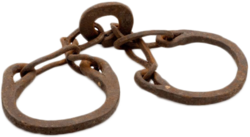
Back Pasaje del medio Spanish Kolmiokaupan keskiosuus Finnish Passage du milieu French מעבר הביניים HE ミドル・パッセージ Japanese Middenpassage Dutch Mellompassasjen NB Middle Passage SIMPLE

| Part of a series on |
| Forced labour and slavery |
|---|
 |
The Middle Passage was the stage of the Atlantic slave trade in which millions of Africans sold for enslavement [1] were forcibly transported to the Americas as part of the triangular slave trade. Ships departed Europe for African markets with manufactured goods (first side of the triangle), which were then traded for captive Africans. Slave ships transported the African captives across the Atlantic (second side of the triangle). The proceeds from selling these enslaved people were then used to buy products such as furs and hides, tobacco, sugar, rum, and raw materials,[2] which would be transported back to Europe (third side of the triangle, completing it).
The First Passage was the forced march of Africans from their inland homes, where they had been captured for enslavement by rulers of other African states or members of their own ethnic group, to African ports. Here they were imprisoned until they were sold and loaded onto a ship. The Final Passage was the journey from the port of disembarkation in the Americas to the plantation or other destination for enslavement into forced labor. The Middle Passage across the Atlantic joined these two. Voyages on the Middle Passage were large financial undertakings, generally organized by companies or groups of investors rather than individuals.[3]
The first European slave ship transported African captives from São Tomé to New Spain in 1525. Portuguese and Dutch traders dominated the trade in the 16th and 17th centuries, though by the 18th they were supplanted by the British and French. Other European nations involved were Spain, Denmark–Norway, Sweden, Poland–Lithuania, Prussia, and various Italian city-states as well as traders from the United States. The enslaved Africans came mostly from the regions of Senegambia, Upper Guinea, Windward Coast, Gold Coast, Bight of Benin, Bight of Biafra, and Angola.[4] With the growing abolitionist movement in Europe and the Americas, the transatlantic slave trade gradually declined until being fully abolished in the second-half of the 19th century.[5][6]

According to modern research, roughly 15 million enslaved Africans were transported through the Middle Passage to the Americas.[8] They were transported in wretched conditions, men and women separated, across the Atlantic. Mortality was high; those with strong bodies survived. Young women and girls were raped by the crew. An estimated 19% of them died during voyage, with mortality rates considerably higher in Africa itself during the process of capturing and transporting the enslaved people to the coast.[9] The total number of deaths directly attributable to the Middle Passage voyage is estimated at up to two million; a broader look at African deaths directly attributable to the institution of slavery from 1500 to 1900 suggests up to four million deaths.[10] The "Middle Passage" was considered a time of in-betweenness where captive Africans forged bonds of kinship, which then created forced transatlantic communities.[11]
- ^ McKissack, Patricia C.; McKissack, Frederick (1995). The Royal Kingdoms of Ghana, Mali, and Songhay. Macmillan. p. 109. ISBN 0805042598.
- ^ Walker, Theodore (2004). Mothership Connections. p. 10.
- ^ Thomas, Hugh (1999). The Slave Trade: the story of the Atlantic Slave Trade, 1440–1870. New York: Simon & Schuster. p. 293. ISBN 0684835657.
- ^ Lovejoy, Paul E. (2000). Transformations in Slavery. Cambridge University Press.
- ^ Bennett, Herman L. (2009). Colonial Blackness: A History of Afro-Mexico. Indiana University Press. p. 11. ISBN 9780253223319.
- ^ Wolfe, Brendan (2021). "Slave Ships and the Middle Passage". In Miller, Patti (ed.). Encyclopedia Virginia. Charlottesville, VA: Virginia Humanities – Library of Virginia. Retrieved 4 March 2021.
- ^ "Boston Slavery Exhibit | Boston.gov". www.boston.gov. 2024-02-23. Retrieved 2024-04-25.
- ^ Slave Voyages, Trans-Atlantic Slave Trade – Estimates
- ^ Mancke, Elizabeth and Shammas, Carole. The Creation of the British Atlantic World, 2005, pp. 30–31.
- ^ Rosenbaum, Alan S.; Charny, Israel W. (17 April 2018). Is the Holocaust Unique?. Routledge. p. 132. ISBN 9780429974762.
- ^ Bell, Karen B. (2010). "Rice, Resistance, and Force Transatlantic Communities: (Re)Envisioning the African Diaspora in Low Country Georgia, 1750–1800". Journal of African American History. 95 (2): 157–182 [p. 158]. doi:10.5323/jafriamerhist.95.2.0157. S2CID 140985496.
© MMXXIII Rich X Search. We shall prevail. All rights reserved. Rich X Search